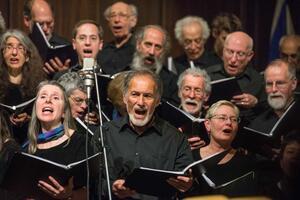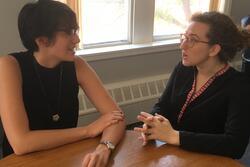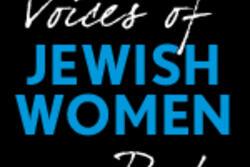Twenty Years of Singing for Bread and Roses
This year, the Boston Workmen’s Circle, a progressive community for Jewish life and social justice, will celebrate its 30th anniversary, and the organization’s Yiddish chorus, A Besere Velt (A Better World), will celebrate its 20th. “The repertoire of A Besere Velt grew out of the shtetls, the sweatshops and union meetings, the camps and ghettos” and explores themes of justice and revolution, uplifting the voices of women and other marginalized groups. As the choir sings in “Bread and Roses,” “The rising of the women means the rising of us all.”
I spoke with original chorus members, Michael Felsen and Jenny Silverman, about the choir’s conception, past, present, and future.
Rebecca Long: What was the impetus for the creation of a Yiddish Choir?
Michael Felsen: [We were] on Jenny's back porch, and we were brainstorming new ideas for enriching our community experience. One of us said: "Let's start a Yiddish chorus!" We all chuckled, but then the idea sank in: Why not? Several of us loved to sing, Yiddish was part of Workmen's Circle identity, and we knew Lisa Gallatin, the talented director of the since-disbanded women's labor chorus, On the Line, who might be available to lead us. Lisa was dubious at first, but curious, and decided to give it a go … before we knew it, we had grown to almost 100 strong, the largest Yiddish chorus, as we're fond of saying, "in the known universe."
RL: Asher Milbauer, Professor at Florida International University, calls Yiddish "a language of resistance and a language of exile." Many of the songs performed by A Besere Velt are indeed anthems of resistance and of exile. What is the cultural significance of singing songs about struggle and social justice in Yiddish?
MF: So many of us have spent our lives engaged in struggles for peace and social justice of one kind or another; it's in our blood, so singing Yiddish songs with those themes really resonates. They also connect us with those who waged these struggles in conditions far more directly challenging than most of us today deal with in our lives in the U.S.—problematic as U.S. politics have been and certainly are today. By singing these songs of resistance and exile that were born out of their pain and their hope, we humbly honor the enormous struggles of our kin/kindred spirits. And, we recharge our own batteries for the work here and now.
Jenny Silverman: As we learn these songs, I am struck by the idealism and conviction of the Yiddish socialists at the turn of the last century that a better world is coming! Although we have not yet gotten to that “new world,” I find it inspiring to continue this long tradition of social-justice activism. It also fuels our desire for A Besere Velt to be an “activist” chorus.
RL: How does A Besere Velt amplify the voices of Jewish women?
MF: I defer to Jenny on this one!
JS: Women have been at the heart of A Besere Velt from the very beginning. Our founding director, Lisa Gallatin, directed us for seventeen years, and her vision and creative spirit continue to live on in our performances today. Our chorus is an example of an intergenerational and multi-gender singing community that has become “family” for so many of us, and enhances our lives through harmony and song.
RL: Tell me about your favorite song in A Besere Velt’s repertoire. What’s its history? What is its significance to you?
MF: I can't choose a single song as my favorite—there really are too many that I find just take me to a whole other place. Songs of longing for a homeland gone, of family and romantic love, or work, of loss, of struggle and hope. All so evocative of a place or places far away, of another time, and yet deeply connected to who we are, to who I am.
JS: Yes—so many to choose from. What I love about A Besere Velt is that we have learned so many songs—I have two notebooks filled with sheet music we have learned over the past 20 years. As we learn new songs, we continue to pull old ones out and revive them. “Yugnt Himen” is one of my favorites … It is the Youth Hymn of the Vilna Ghetto. I also love the “mash-ups” that combine Yiddish songs with English social justice songs in surprising ways. Some of my favorites are “Bread and Roses / Makhnes Geyen” and “Bruderschaft Lid”—which brings in elements of “We Shall Not Be Moved.”
RL: In a Tablet Magazine piece, Batya Ungar-Sargon states that Yiddish "is not simply a language. It’s a culture, an identity, a past both comic and tragic." What is your personal connection to the Yiddish language?
MF: My grandfathers on both sides were raised in Poland and Yiddish was their primary language, but both my parents grew up in Germany, and Yiddish wasn't their mode of communication. They escaped the Nazi regime and came to America, so it was German I heard growing up, but mostly when they didn't want me and my sister to understand. I didn't find myself appreciating the rich history and culture embedded in Yiddish until I began associating with Workmen's Circle.
JS: Like many Ashkenazi Jews of my generation, growing up in the 1950s and ‘60s, I was around Yiddish, but mostly heard it as the punchline of jokes (which were frustrating not to understand!) … my father’s first language was Yiddish until he went to elementary school. It wasn’t until I began singing in the chorus, that I became aware that my grandparents were active in the Workmen’s Circle in Los Angeles in the 1920s, and that my father and his brothers went to a Shule there to learn to read and write in Yiddish. My participation in the chorus and learning the Yiddish songs has made me feel very connected to that history.
RL: A Besere Velt has performed at concerts, marches, and community events, and with other choirs and bands, such as The Klezmatics. Tell me about your favorite performance.
MF: We [have] collaborated with many wonderful individuals and groups, from gospel choirs to jazz pianists to Ladino folk artists. To me, our most stirring performances commemorated the Triangle Shirtwaist Factory fire, 100 years later, including a performance in New York City just blocks from the site of that tragic event. Not many of us left that performance with dry eyes.
JS: It’s so hard to say which has been my favorite. Each collaboration has been quite different. It hasn’t been just the music, but the scripts and visual presentations that have gone along with the shows … Performing with the Klezmatics in NYC outside at Lincoln Center was a huge thrill, particularly for me as a New Yorker … I agree with Mike about the Triangle Shirtwaist Factory Fire show—we performed it a number of times in different venues, and it remains the most powerful piece we have created. We even performed it in Barre, Vermont, at the historic Opera House, where socialist Eugene Debs and anarchist Emma Goldman once appeared.
A Besere Velt has been singing songs of history and social justice for twenty years. Learn more about their upcoming performances throughout the Boston area.







